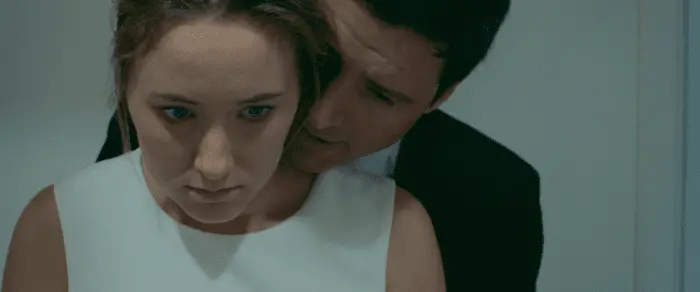Discomfort and unease take center stage in Screwdriver, the new psychological thriller from first-time feature-film director and writer Cairo Smith The movie stars AnnaClare Hicks as Emily, a divorcee from Nebraska who leaves midwestern life behind to stay with her accommodating childhood friend Robert (Charlie Farrell) and his oddly high-strung wife, Melissa (Milly Sanders). As the couple tries to help Emily work through some of her emotional issues, things start to unravel—and Emily begins to question the couple’s true intentions.
Smith spoke recently with Film Obsessive about the challenges of delving into his first feature-length film, and what surprised him most about the process.
Film Obsessive: What drew you toward the psychological thriller genre for your first film?
Cairo Smith: I was writing a lot of short stories at the time that this came to me, and initially that’s what I thought it would be. But there was something about it that resonated to the point where I knew it could be more. That’s where I realized we had not only a feature, but a feature that we could actually practically shoot on a limited budget and still achieve the full effect intended by the narrative. That was an opportunity I couldn’t resist. I wanted to make a film that would honor the films that had made such an impression on me as a teenager. A lot of those lived in a place of this deep psychological discomfort, so it was a natural fit.
As the film progresses, the tension and overall feeling of unease grows steadily. What types of elements did you use to achieve these?
There’s a lot we did. As you can see in the film, because the location was so constant, we needed other variables to shift to transform the tone. We built a lot of very cool lighting setups, where we would have a harsh topper—almost like an interrogation light—and then we would have softer fill lighting that was more conventional. We would set things up so that over the course of the scene, even during one long take, the fill lights would dim, and we’d increase the brightness of the topper. This way you would very subtly—almost subliminally—get this harshness of lighting. During both therapy scenes, for example, we did that. Obviously, Sean Renner’s score is just fantastic with the way it builds tension, and we introduced new instruments. At different moments, there’s a synth that comes in at the climax, and it just absolutely blows me away every time I hear it.

How do you want the viewer to feel about the three main characters?
Well, I see parts of myself in all of them. I would imagine one can do that. That’s generally how I try to approach a character. I think there’s a large element of pity. These characters are so deeply unhappy, and they are so bad at getting what they want. They cause so much harm and are so completely unable to communicate in a symbiotic way. I don’t think there’s anything to admire, but there’s certainly a lot that can serve as a kind of jumping off point for personal reflection, and perhaps also as a warning.
Is there a message or a specific feeling you want the viewer to walk away with after watching?
I’ll let the viewer derive that for yourself from the text of the film.
Which scene was most challenging to film?
There were a couple scenes that were challenging in different ways. There’s one moment where Emily comes down to get a drink of water, and from a technical perspective it’s quite straightforward. But something about the performance just wasn’t clicking, and both the actress and I could feel it. After a few takes, we looked at each other and stepped aside and said, “OK, we need to fix this. What do we do?”
We talked through the script, and we realized that Emily is surprisingly lucid for just a moment there, and we needed to pull her back into this realm of assertiveness and lucidity in order for it to land. I’m just really grateful we were able to problem-solve together on the spot in such a good way. From a technical perspective, there’s a stunt involving a drink at the climax that was quite complex. We had a bunch of people holding the chair and setting up sort of a spill trough and working really hard to make sure nobody got hurt at any point.
Since this is your first screenplay/feature length film, what about the process surprised you the most? What lessons did you learn that you would pass along to other first-timers?
What surprised me was how long it takes to do a lighting setup, and the sheer physical effort of all the furniture moves and equipment moves. I’m very grateful to the art department and electrical teams for all the sweat they put into the film. What I would say to first timers is study acting, spend time putting yourself in the position of the actor, and know what it feels like to be directed so you can approach directing with empathy. Really listen to your talent and support them when you’re there on set. You have a director of photography there as a backup for the technical stuff, but you are really the only advocate for the actors in terms of performance, and you need to be available to them.
Screwdriver is available to rent on VOD now.




